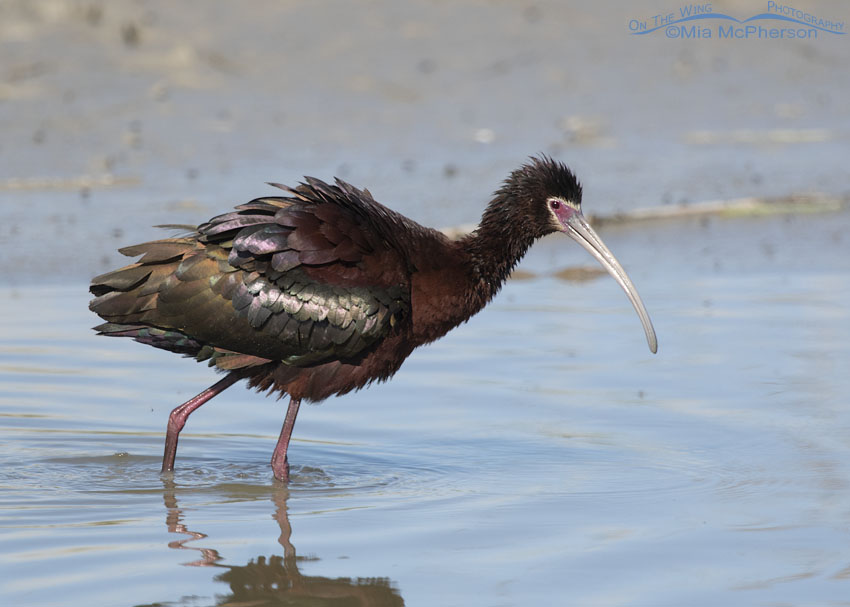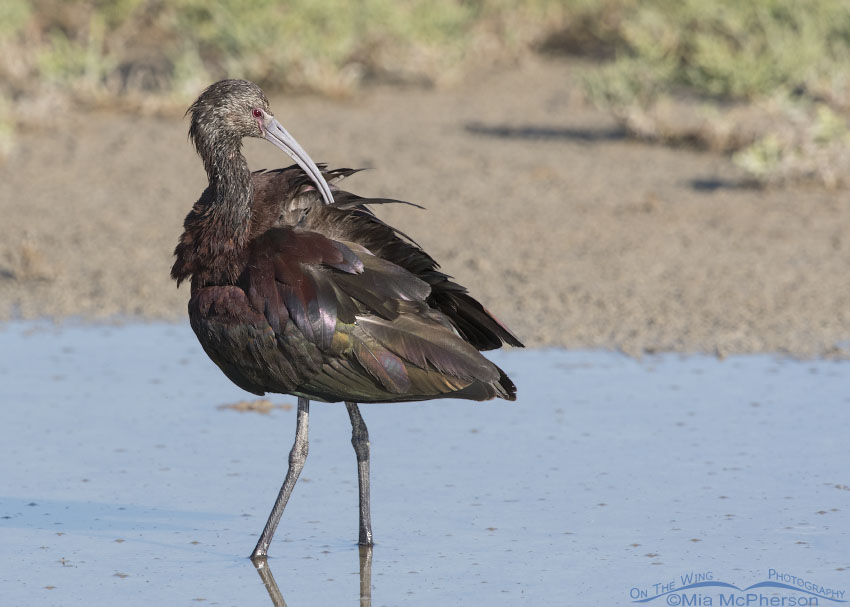 White-faced Ibis in breeding plumage all fluffed up (May 2018) – Nikon D500, f6.3, 1/2000, ISO 500, Nikkor 500mm VR with 1.4x TC, natural light
White-faced Ibis in breeding plumage all fluffed up (May 2018) – Nikon D500, f6.3, 1/2000, ISO 500, Nikkor 500mm VR with 1.4x TC, natural light
In just a few weeks the White-faced Ibis that are in breeding plumage (Definitive Alternate Plumage) right now will begin to molt into their nonbreeding plumage (Definitive Basic Plumage) and I thought this might be a good time to show some of the differences.
I took this photo of a White-faced Ibis three days ago at Bear River Migratory Bird Refuge while I was showing my mother the birds I photograph at the refuge this time of the year. There were several White-faced Ibis close enough to take photos of that were foraging in the shallow water of the marshes.
In breeding plumage (aka Definitive Alternate Plumage) White-faced Ibis have carmine colored legs, the lores, eyelids and bare skin of the chin also become bright carmine. The chest, vent, thighs, scapulars, mantle, neck and head are a dark chestnut color that is tinged with purple on the forehead, neck, chin and crown. A continuous narrow band of white feathers borders the bill, lores, chin, bill and eyes. The feathers that are metallic greens, purples, bronzy greens, pinks appear more richly or vividly colored in breeding plumage.
 White-faced Ibis in nonbreeding plumage preening at Bear River (Aug 2017) – Nikon D500, f7.1, 1/1000, ISO 400, Nikkor 500mm VR with 1.4x TC, natural light
White-faced Ibis in nonbreeding plumage preening at Bear River (Aug 2017) – Nikon D500, f7.1, 1/1000, ISO 400, Nikkor 500mm VR with 1.4x TC, natural light
In nonbreeding plumage (aka Definitive Basic Plumage) White-faced Ibis have olive gray legs, the lores, eyelids and bare skin around the chin lack the carmine coloration. White-faced Ibis in nonbreeding plumage lack the white feathers on the face. Their necks, crowns and head are dark with some dull light to white streaking and their scapulars, mantles, vents and chest are a dull dusky brown as opposed to the brighter chestnut color seen in breeding plumage.
Whether they are in breeding or nonbreeding plumage I enjoy photographing the White-faced Ibis that make their homes in the marshes surrounding the Great Salt Lake while they are here to mate, nest and rear their young.
Life is good.
Mia
Click here to see more of my White-faced Ibis photos plus facts and information about this species.


Terrific shots Mia. I love the iridescent sheen of the feathers and, of course, the detail. Beautiful. Thanks.
Thank you.
I find myself a tad jealous. Of you for the amazing sights you see and capture. And of birds – whose outfits ALWAYS fit.
I love the beak! Years ago when we had a non-releasable ibis in rehab I would clean it’s cage (I always wore water sandals because my feet were always wet) the ibis would probe it’s beak in between my toes, it was a fun feeling. I would stand still and giggle, it was very gentile and never pinched.
Please note I would not have done this if it was a releasable bird or put the bird into any danger. This bird was not releasable and went on to a aviary.
Never knew they’re so beautiful.
Wonderful photographs! Of course, I’m jealous since we seldom see a White-faced Ibis here in central Florida.
When the light is right, the iridescent plumage of these birds is just spectacular!
Thank you for sharing!
Interesting birds…like the iridecence in the breeding plumage….as Univ. of Miami alum. These are special birds…our mascot.
Great info!
What a beautiful bird. Love the colouring of the breeding plumage.
Cool photos, Mia